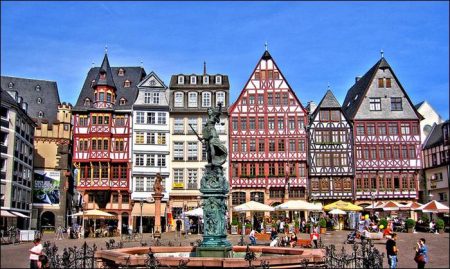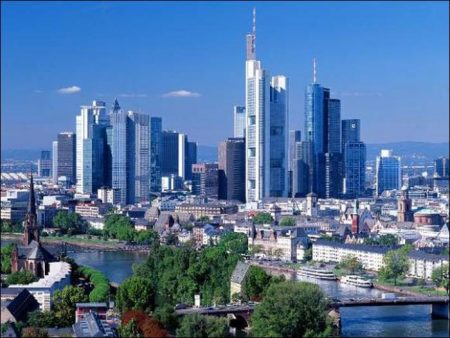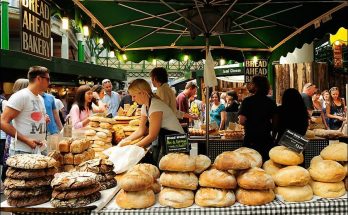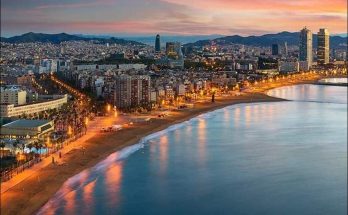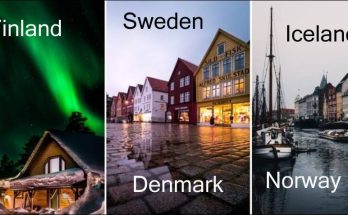Frankfurt is equally proud of its international trade fairs and of Goethe, whose birthplace is now a museum (Grosser Hirschgraben 23). The highlights of the old part of town are the steeply gabled Gothic bulidnigs on Römerberg square, including the Town hall with the Emperor’s Coronation Hall, the Cathedral with its tall 15th century bell tower, St Leonhard’s and St Nicholas’ churces and the Carmelite monastery which houses a museum. Frankfurt Zoo is one of world’s greatest: afternoon concerts and plays are presented here.
Frankfurt Landmarks
Römer
“Römer” is the German word for “Roman” and the name of a complex of nine houses that form Frankfurt city hall (Rathaus). The houses were acquired by the city council in 1405 from a wealthy merchant family. The middle house became the city hall and was later connected with its neighbours. The Kaisersaal (“Emperor’s Hall”) is located on the upper floor and is where the newly crowned emperors held their banquets. The Römer was partially destroyed in World War II and later rebuilt. The surrounding square, the Römerberg, is named after the city hall.
The former Altstadt (old town) quarter between the Römer and the Frankfurt Cathedral was to be redeveloped as the Dom-Römer Quarter through 2016, including reconstructions of historical buildings that were destroyed during World War II.
Frankfurt Cathedral (Dom)
Saint Bartholomew’s Cathedral (Dom Sankt Bartholomäus), (named after Bartholomew the Apostle), is a Gothic building constructed in the 14th and 15th centuries on the foundation of an earlier church from the Merovingian time. From 1356 onwards, kings of the Holy Roman Empire were elected in this church, and from 1562 to 1792, Roman-German emperors were crowned there. It is the city’s main church.
Since the 18th century, St. Bartholomew’s has been called “the cathedral” by the people, although it was never a bishop’s seat. In 1867, it was destroyed by fire and rebuilt in its present style. It was again partially destroyed in World War II and rebuilt in the 1950s. Its height is 95 meters. The cathedral tower has a viewing platform open to the public at a height of 66 meters, accessed through a narrow spiral staircase with 386 steps.
Frankfurt Cathedral (Dom)
Saint Bartholomew’s Cathedral (Dom Sankt Bartholomäus), (named after Bartholomew the Apostle), is a Gothic building constructed in the 14th and 15th centuries on the foundation of an earlier church from the Merovingian time. From 1356 onwards, kings of the Holy Roman Empire were elected in this church, and from 1562 to 1792, Roman-German emperors were crowned there. It is the city’s main church.
Since the 18th century, St. Bartholomew’s has been called “the cathedral” by the people, although it was never a bishop’s seat. In 1867, it was destroyed by fire and rebuilt in its present style. It was again partially destroyed in World War II and rebuilt in the 1950s. Its height is 95 meters. The cathedral tower has a viewing platform open to the public at a height of 66 meters, accessed through a narrow spiral staircase with 386 steps.
Saint Paul’s Church
Saint Paul’s Church (Paulskirche) is a national historic monument in Germany because it was the seat of the first democratically elected Parliament in 1848. It was established in 1789 as a Protestant church, but was not completed until 1833. Its importance has its roots in the Frankfurt Parliament, which met in the church during the revolutionary years of 1848/49 in order to write a constitution for a united Germany. The attempt failed because the monarchs of Prussia and Austria did not want to lose power. In 1849 Prussian troops ended the democratic experiment by force and the parliament dissolved. Afterwards, the building was used for church services again.
St. Paul’s was partially destroyed in World War II, particularly its interior, which now has a modern appearance. It was quickly and symbolically rebuilt after the war; today it is used mainly for exhibitions and events.
Archäologischer Garten Frankfurt
The Archaeological Garden contains small parts of the oldest recovered buildings: an ancient Roman settlement and the Frankfurt Royal Palace (Kaiserpfalz Frankfurt) from the 6th century. The garden is located between the Römerberg and St. Bartholomew’s. It was discovered after World War II when the area was heavily bombed and later partly rebuilt. The remains were preserved and are now open to the public. There are plans underway to construct a building on top of the garden but anyhow it is decided that the garden will stay open to the public.
Haus Wertheim
Wertheim House is the only timbered house in the Altstadt district that survived the heavy bombings of World War II undamaged. It is located on the Römerberg next to the Historical Museum.
Saalhof
The Saalhof is the oldest conserved building in the Altstadt district and dates to the 12th century. It was used as an exhibition hall by Dutch clothiers when trade fairs were held during the 14th and 15th century. The Saalhof was partly destroyed in World War II and later rebuilt. Today it serves as a part of the Historical Museum.
Eiserner Steg
The Eiserner Steg (Iron Bridge) is a pedestrian-only bridge over the Main river that connects Römerberg and Sachsenhausen. It was built in 1868 and was the second bridge to cross the river. After World War II, when it was blown up by the Wehrmacht, it was quickly rebuilt in 1946. Today some 10,000 people cross the bridge on a daily basis.
Hauptwache
Although today “Hauptwache” is mostly associated with the inner-city underground train station of the same name, the name originates from a baroque building on the square above the station. The Hauptwache building was constructed in 1730 and was used as a prison, therefore the name that translates as “main guard-house”. Today the square surrounding the building is also called “Hauptwache” (formal: An der Hauptwache). It is situated in the city centre opposite to St. Catherine’s Church and houses a famous café.
Frankfurt Central Station
Frankfurt Central Station (Frankfurt Hauptbahnhof), which opened in 1888, was built as the central train station for Frankfurt to replace three smaller train stations in the city centre and to boost the needed capacity for travellers. It was constructed as a terminus station and was the largest train station in Europe by floor area until 1915 when Leipzig Central Station was opened. Its three main halls were constructed in a neorenaissance-style, while the later enlargement with two outer halls in 1924 was constructed in neoclassic-style.
Views: 184
